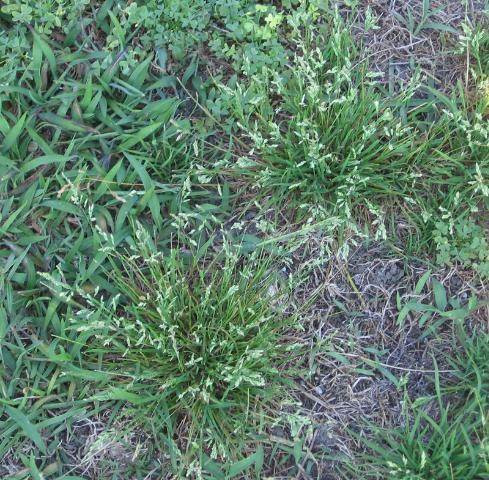
by Les Harrison | Feb 10, 2016
Weeds grow everywhere, especially in manicured lawns and landscapes despite the best efforts of owners who have spared no expense to remove the offending flora.
The reality, at least about the herbicides, is different from perceived appearances. Herbicides can be a wonderful tool for the homeowner, if applied properly.
The first point to remember about herbicides is to always, Always, ALWAYS apply them as instructed by the label directions. The oft quoted mantra of “the label is the law” is accurate.
Herbicides and their labeling are periodically reviewed and assessed to confirm effectiveness against target weeds without damaging the environment. Not following the label directions can have many negative implications for both the environment and the applicator.
Herbicides are either selective or non-selective when killing plants. Non-selective herbicides kill or damage every plant, but selective herbicides target a narrower range of plants.

Annual Bluegrass – Image Credit Larry Williams
Never apply herbicides when there is a breeze or wind. Herbicide drift can injure or destroy plants that are not the intended target.
High temperatures can contribute to the drift problem by volatizing some of the herbicide spray. Even the lightest air movement will cause drift off the target weeds when this condition exists. Herbicide drift can also be deposited in ponds and streams, harming the aquatic creatures that live there. Some herbicides are toxic to fish, insects and other animals that can be killed by tiny amounts of the active chemical. Additionally, the off target herbicides can kill aquatic plants. When the dead plants decay, they deplete the water of oxygen, again threatening or ending the life of the water’s residents.
Rain or dew resulting from high humidity can negate a herbicide’s application. If a leaf is wet, most or all the herbicide will run off on to the soil where it can leach into the water table.
Regular herbicides work only when the plant is actively growing. Pre-emergent suppresses the growth of the weed seedling above the soil level.
Many weeds have already produced seeds for next spring. Herbicides applied now will not affect the germination of that seed months from now.
The most effective strategy is to mow weeds before they set seed or to collect and destroy those which have already produced seed. Even with 100 percent success at eliminating this year’s weed seed crop, there will be weeds next year.
Some weed seed remain in the soil, sometimes for decades, only to germinate when conditions are perfect for their sprouting. Sickle pod and crotalaria are local examples of long term seed vigor.
Other seed can blow in or be dropped by wild or domestic animals passing through the property. A pre-emergent herbicide which stops germination can help control these latent invaders.
For more information:
Weed Management Guide for Florida Lawns
Chemical Weed Management
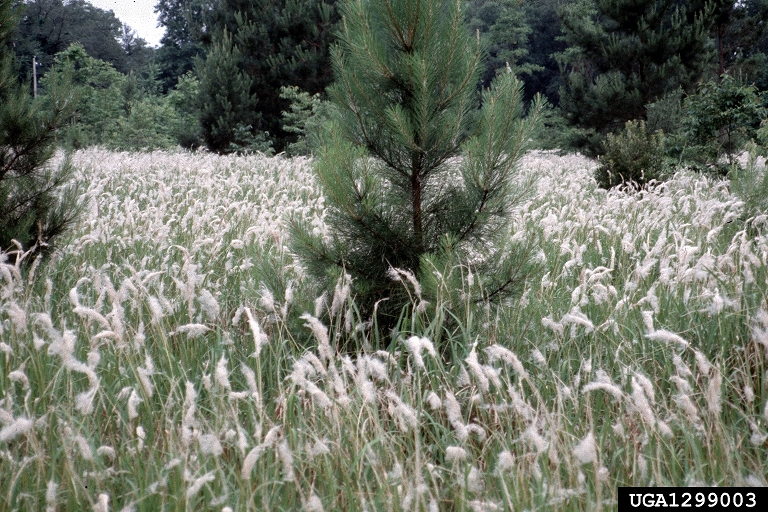
by Mary Salinas | Oct 14, 2015
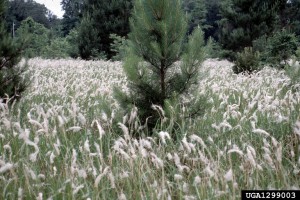
Cogongrass dominating the landscape. Photo credit: Charles T. Bryson, USDA Agricultural Research Service, Bugwood.org.
A U.S. Forest Service grant is again available to assist non-industrial private landowners with the cost of controlling cogongrass. Applications will be accepted starting October 15, 2015. The program reimburses landowners for 50% of the cost for two consecutive years with a maximum reimbursement of $10,000 for each year.
Cogongrass is one of the worst invasive plant species in Northwest Florida as it marches through natural areas and literally chokes out our desirable native vegetation as it goes. The underground rhizomes continually expand patches of the grass in every direction and its prolific seed production carries infestations to new areas.
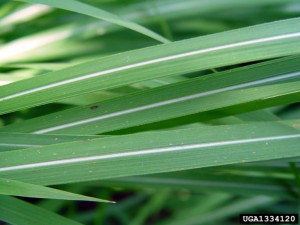
Note the off center midrib along the leaf blade. Photo credit: Chris Evans, Illinois Wildlife Action Plan, Bugwood.org.
There are several ways to accurately identify cogongrass. The leaf blades are flat with serrated edges and tend to be yellowish-green in color. The midrib which runs lengthwise up each leaf blade is white and is distinctly off-center. The seed head which arises in the spring is a fluffy white plume. Since it spreads through rhizomes, cogongrass is often seen in expanding circular patches.
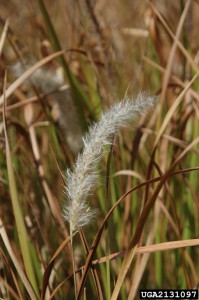
The fluffy white plume of the seedhead. Photo credit: Chris Evans, Illinois Wildlife Action Plan, Bugwood.org.
If you need assistance with the identification of cogongrass, please consult your local Extension office.
For more information:
Cogongrass Treatment Cost-Share Program
Cogongrass (Imperata cylindrica) Biology, Ecology, and Management in Florida Grazing Lands
by Mary Salinas | Feb 2, 2015
So often, homeowners wait until weeds have overtaken their lawns in mid-summer before looking for a course of action to control them. Unfortunately, when weeds get to maturity and start producing flowers and going to seed, they are usually quite difficult to control.
[important]The best strategy is to prevent the weeds from getting established in the first place![/important]
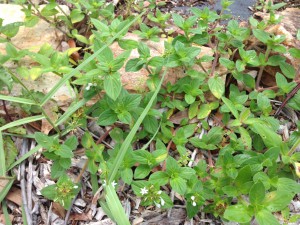
Florida pusley, an annual weed that can be controlled with preemergence herbicides. Photo credit: Mary Derrick UF/IFAS Extension.
When properly applied, a preemergence herbicide forms a chemical barrier on the surface of the soil that kills newly germinated seeds when they grow and contact that barrier. Be sure to follow label directions carefully as it is crucial to apply the correct amount and water it in correctly. The soil surface should not be disturbed after application to ensure that the chemical barrier remains intact.
Keep in mind that preemergence herbicides only prevent annual weeds! They do not control weeds that have already emerged.
In North Florida, the time to apply a preemergence herbicide to your turfgrass is coming soon. As a general rule, March 1 is an ideal time. Another indicator that the time is right is when the daytime temperatures reach 65°F-70°F for 4 to 5 consecutive days as that sustained warmth will prompt weed seeds to germinate. Oftentimes, this is also when azaleas or dogwoods start blooming and that can clue you into when to apply the herbicide. For best results, follow up with a second application in 6 to 9 weeks to control those seeds germinating later in the season.
Always follow the label instructions precisely when applying any herbicide! Ensure that you apply the product at the correct rate, that it is suitable for your specific turfgrass and situation, and that it is watered in correctly. For any pesticide, the label is the law!
If your lawn has problems with winter weeds, make a note on your calendar to apply a preemergence herbicide about October 1 in North Florida or when nighttime temperatures drop to 55°F-60°F for several consecutive days.
For more information on weed control in lawns:
Weed Management Guide for Florida Lawns
For general information on lawn care in Florida:
UF/IFAS Gardening Solutions: Lawns






